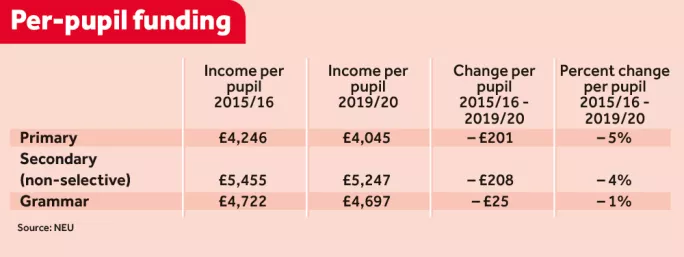‘Discriminating against primaries is disastrous’

It was the standout pledge in Justine Greening’s big school funding announcement at the start of term. The promise to give primary schools at least £3,500 per pupil followed months of lobbying and came after an earlier decision to set a minimum sum at secondary.
However, new analysis suggests that the amount falls far short of what primaries need - and that primary schools will, in fact, fare worst under the government’s funding plans, compared with other types of school.
The analysis, carried out by the NEU teaching union and shared with Tes, shows that primary pupils will attract 5 per cent less cash in real terms by 2020, compared with 2015. This represents a £201 cut per pupil over five years, taking account of inflation and rising costs such as increased national insurance contributions.
By contrast, non-selective secondary schools will see their per-pupil budgets fall by 4 per cent in real terms, while grammars will experience a 1 per cent funding drop, according to the findings.
The percentage-point difference between future funding for primaries and secondaries equates to many millions of pounds. It is one of the “many unintended outcomes of under-funding the national funding formula”, according to Andrew Morris, the NEU’s assistant general secretary for funding.
‘A disastrous move’
It is unclear why exactly primaries look to be hit harder than secondaries. One explanation could be that the minimum per-pupil amount for secondaries amounts to a bigger uplift on average than that for primaries.
But it runs counter to calls for the gap between primary and secondary funding to be narrowed to ensure that children are taught the building blocks they need to succeed later.
John Coe, of the National Association for Primary Education, says: “The government’s intention, under the new funding formula, to discriminate against primary schools is a disastrous move in the wrong direction.
“We should be moving progressively towards equalising expenditure on primary and secondary children, and not the reverse.”
For him, this is far more than just a decision about resources. “The government’s plans reveal that ministers still lack understanding of the vital importance of primary education,” he says. “For many children, the future is decided by the time they reach 11 years old. Their schools must be properly resourced.”
Worry and anger
As Coe highlights, there is not just concern at the fact that primary schools will receive less per pupil than secondaries - after all, this has long been the case in many areas. It is the real risk that their schools will fall even further behind that worries - and angers - some primary heads.
Lynn Knapp, headteacher at Windmill Primary School in Oxford, says she finds it “extremely worrying that primary schools will not be funded as well as secondary schools” overall. “The education that children receive at primary level is every bit as important as the one they receive when they transfer into secondary schools,” she adds.
There is clear evidence that children who transfer from primary to secondary reaching the expected levels at English and maths are far more likely to do well at GCSE, she says.
In her 20 years as a headteacher, pressure from her local authority has made this year the “hardest budget I think we’ve ever had” and “there are no reserves at all” to deal with any unexpected costs.

On average, per-pupil funding is 29 per cent higher for secondary schools than primary schools. In the Department for Education’s consultation on the national funding formula, maintaining the status quo was supported by the biggest proportion - 40 per cent - of respondents. Most of them pointed to the greater complexity of the secondary curriculum and the need for secondary schools to have a wider range of facilities, such as IT suites and science labs.
But a large proportion - 31 per cent - thought that primary and secondary funding should be brought closer together, with some respondents stressing the importance of early intervention and the role of primary schools in identifying and supporting pupils who have particular needs.
However, the government’s consultation response says that “there is no compelling evidence or consensus at present that suggests the overall balance should be shifted towards primary or secondary and we proposed to reflect that average in the national funding formula”.
The DfE was contacted for comment.
You need a Tes subscription to read this article
Subscribe now to read this article and get other subscriber-only content:
- Unlimited access to all Tes magazine content
- Exclusive subscriber-only stories
- Award-winning email newsletters
Already a subscriber? Log in
You need a subscription to read this article
Subscribe now to read this article and get other subscriber-only content, including:
- Unlimited access to all Tes magazine content
- Exclusive subscriber-only stories
- Award-winning email newsletters